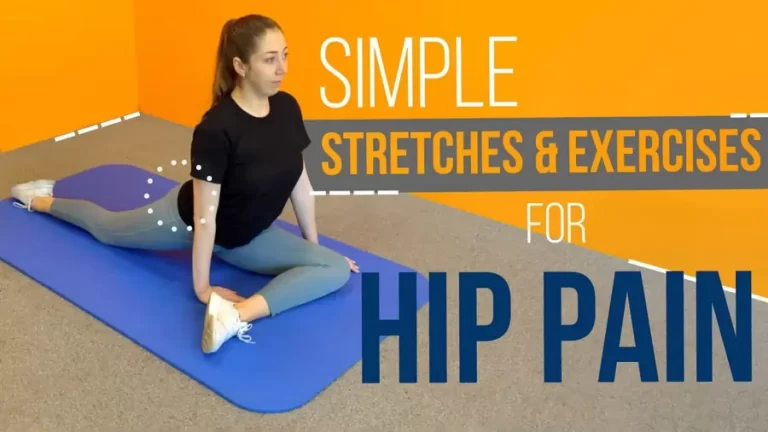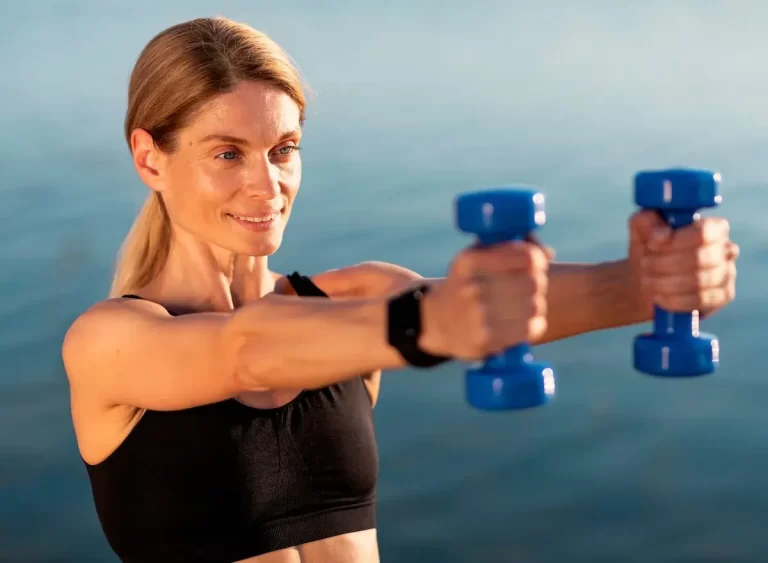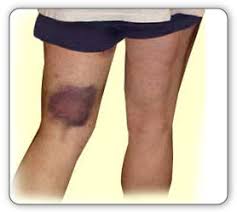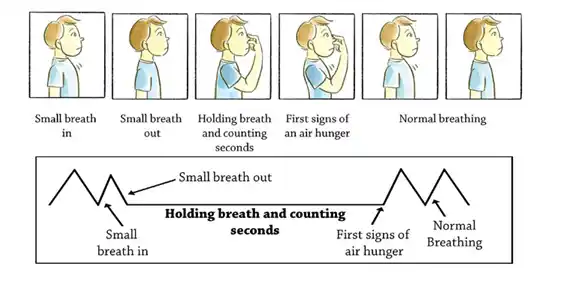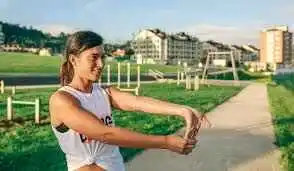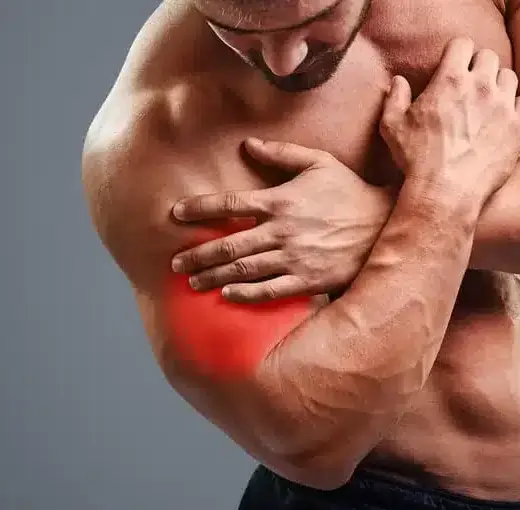Chakrasana (Wheel Pose)
What is Chakrasana (Wheel Pose)?
Chakrasana, commonly known as the Wheel Pose, is a rejuvenating backbend yoga asana that derives its name from the Sanskrit words Chakra (wheel) and Asana (pose). This pose symbolizes the circular and cyclical nature of energy, enhancing flexibility and vitality. It is known for its ability to open the chest and shoulders, strengthen the spine, and invigorate the entire body.
Which muscles are used in Chakrasana?
What are the Health Benefits of Chakrasana?
How to Perform Chakrasana?
Chakrasana video:
What are the Types of Chakrasana?
There are some types of chakrasana :
- Ardha chakrasana/half wheel pose:
- Kati Chakrasana
Ardha Chakrasana/half wheel pose
What is Ardha chakrasana?
The “half wheel pose,” also known as Ardha Chakrasana Yoga, is a considerably simpler asana than Chakrasana. Many individuals struggle with full-wheel posture, also known as Chakrasana, while half-wheel pose is well known for being a far simpler asana to perform daily.
In the Sanskrit language, chakra means “wheel,” and ardha means “half.” There are numerous health benefits to performing Ardha-Chakrasana. This asana is known as Ardha Chakrasana or half-wheel position because it causes your body to resemble a half-wheel.
To practice “Ardha Chakrasana” correctly, it is crucial to follow all instructions.
How to perform Standing Backward Bend (Ardha Chakrasana)?
With your feet together and your arms on either side of your torso, take a straight stance.
Assign an equal amount of weight to each foot.
Take a breath and raise your arms above your head, palms facing one another.
Exhale, flex your back softly, push your pelvis forward, keep your arms in a row with your knees, elbows, and ears out, raise your chest toward the ceiling, and keep your head up.
Hold on. Breathe in, then exhale.
Breathe out, lower your arms, and unwind.

Ardha Chakrasana Benefits:
- Thigh and stomach fat can be effectively reduced using Ardha Chakrasana.
- This pose aids in expanding the capacity of your lungs.
- This pose also helps to activate the pancreas and regulate elevated blood sugar levels.
- “Ardha Chakrasana” additionally builds up your back and spine muscles.s.
- This pose helps to tone your waist, shoulders, and other body parts.
- Neck and shoulder pain might be lessened with this pose.
- This pose is well-regarded as one of the best ways to relieve lower back or back pain.
- Yoga’s Ardha Chakrasana helps heal respiratory conditions.
- The abdominal organs are activated by this stance.
- Yoga’s Ardha Chakrasana helps ease and alleviate menstruation discomfort and disorders.
- This pose helps to stretch the muscles in your stomach, intestines, and abdomen.
Ardha Chakrasana Precautions:
- You must speak with your doctor before performing this pose if you are pregnant.
- This pose is not recommended for people with severe hip or spine issues or injuries.
- This pose should not be performed by anyone who has ulcers or hernias.
- This pose should not be performed by people with excessive blood pressure.
- A person who has a neck or abdominal injury shouldn’t perform this pose.
- This stance is also inappropriate for someone who has a dizziness issue.
Kati Chakrasana
What is Kati Chakrasana?
Ardhakati Chakrasana is also known as the half-waist wheel position. The sideways fold from the waist resembles a wheel in this position. The name of the asana is derived from the terms Ardha (half), Kati (waist), and Chakra (wheel). It is among the most well-known poses that are frequently employed for overall body toning.
How to do Kati Chakrasana ?
Place your feet together and stand upright.
Maintain a straight spine. Keep your shoulders straight.
Keep your shoulders and legs at the same distance from one another.
Make sure your hands and shoulders line up.
Hold this stance and keep exhaling as long as you can.
Breathe out and return to the center slowly.
Take your breath deeply and maintain this final posture as long as you can.
Go back to the center and unwind.
This is the posture’s whole cycle.
Depending on convenience, the performance can be repeated ten, twenty, or even more times.
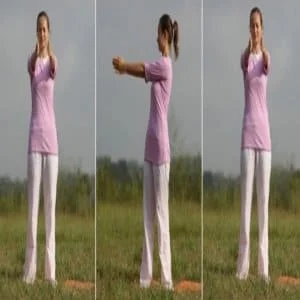
Kati Chakrasana Benefits:
- Excellent for relieving constipation.
- boosts the waist and spine’s flexibility and strength.
- Beneficial for the arm and leg muscles
- It opens up the shoulders and neck while strengthening the muscles in the lower back and abdomen.
- Benefits for people with desk-bound or sedentary occupations
- relieve sluggishness.
- increases the waist’s and spine’s flexibility.
- helps ease back pain.
Contraindication of Kati Chakrasana:
- Any new spinal or abdominal surgery.
- Slipped disc.
- Pregnancy.
- Hernia.
- Chronic spinal disorders.
- Abdominal inflammation.
- Hernia.
Modifications and Variations in Chakrasana
If Wheel Pose is difficult for you, there are a few techniques to make it easier.
- Wall modification
- Poses to progress to Wheel Pose
- A challenging variation of Chakrasana
Wall modification:
Modifications away from the wall
The best adjustments are usually made with props against a wall, but if you’re short on props, there are a few that you can do with just one piece of equipment or without any at all.
Working on the preparation phase of rising onto the crown of the head and not pressing your arms straight out would be the easiest change to make.
Another alternative is to loop a strap shoulder-width apart over both arms, slightly above your elbows. This holds the arms in the proper alignment.
To avoid compression of the lower back, you can also use a strap at the top of the thighs. Check to see whether you’re pressing onto the strap while in the stance. Instead, pull your inner thighs down toward the floor to loosen the strap.
Between your inner thighs, you can hold a block. This works on the inner legs to assist avoid lower back compression as well. As you lift into the stance, try to hold your block, just like in the previous variation. Your lower back will appreciate it, even though it’s a little more difficult than it seems!
Wall modifications with multiple props
For tight shoulders:
- Position two blocks horizontally against the wall. For stability, they are hooked against your baseboard at an angle, which aids in tipping them. If you are unable to reach a baseboard wall, slide your mat up the wall a little, like a tail.
- Put a shoulder-wide strap at your elbow and wrap it over your upper arms.
- Lift your arms and bend your knees while lying between the blocks.
- This overstates the need for external rotation in the upper arms.
For a tight lower back:
- Set the blocks on their faces, with shorter ends towards a wall (low setting). Like a pair of platform shoes, place your feet on them.
- Place your head in the middle of the room and your toes against the wall as you lie down.
- Raise your knees, then place your legs on the blocks.
- Follow the instructions in this article’s “how-to” section to complete steps 2 through 11 while keeping your feet on the blocks.
Poses to progress to Wheel Pose:
- Bridge Pose (Setu Bandha Sarvangasana)
- Supported Fish Pose Variation (Matsyasana)
Bridge Pose (Setu Bandha Sarvangasana)
Bridge Pose is a vital initial step in setting up for Wheel Pose. Keeping your arms down by your sides might be a fantastic alternative chest opener if you are unable to reach overhead for whatever reason, such as an injury or limited immobility.
- Rest on your back.
- Maintain straight legs, feet wider than hips, feet on the floor, knees bent.
- Raise your pelvis as you take a breath.
- Grab the outside borders of your mat or interlace your fingers as you roll your upper arms below you.
- Hold on for eight breaths.
- Come down slowly as you breathe.
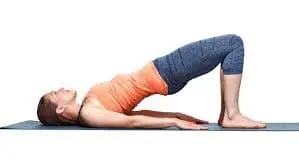
Supported Fish Pose Variation (Matsyasana)
Sometimes it’s your strength, not your flexibility, that’s the issue. Without bearing any weight, you can loosen up your shoulders and chest by performing a Supported Fish Pose on the blocks with your arms extended aloft.
- The top block is usually on the highest setting (sitting on one short end, vertically), while the block nearest your feet is on the medium setting (sitting on one long side).
- Place the back of your skull on the top block and your shoulder blades squarely on the first block while you are lying down.
- Raise your legs straight and aggressively reach through them.
- Slowly start moving your arms toward the rear of the room, parallel to your ears, by reaching them above your chest toward the ceiling.
- You have the option of actively moving your arms up and down or staying in the posture with them overhead.
- Lower your arms by your sides after ten breaths.
- Roll sideways and bend your knees.
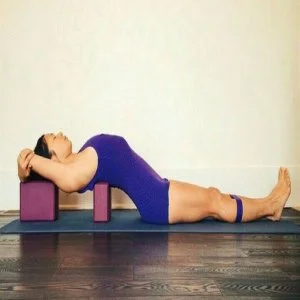
A challenging variation of Chakrasana:
- Straight-Legged Wheel Pose
- One-Legged Wheel Pose
- One-Armed Wheel Pose
- Chest-To-Wall Pose
- Forearm Wheel Pose
Straight-Legged Wheel Pose
Straightening the legs in the Wheel not only makes this variant look very elegant but also gives the legs more power and allows the hip flexors to stretch more deeply.
How to do :
Press down lightly into your palms while maintaining a regular Wheel Pose.
As you start to move your feet a little bit more from your hands until you can fully extend the legs, open your chest.
Try to balance your weight between your hands and feet while maintaining an extremely active core.
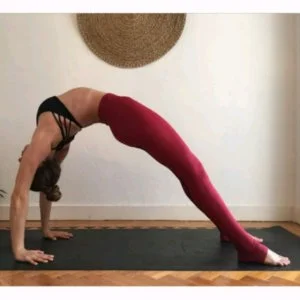
Eka Pada Urdhva Dhanurasana (One-Legged Wheel Pose)
This difficult version demonstrates balance and strength. Your arms, core, and other legs must work harder when you raise one leg off the ground, which builds deeper strength.
How to do :
Put yourself in the typical Wheel Pose position.
As much as it still feels comfortable in your lower back, try to bring your feet close to your hands.
You can either raise your heels and balance on the balls of your feet, which may allow you more room to move, or you can maintain your heels on the ground. Maintain a hip distance between your legs and your feet.
Start by bringing your knee close to your chest and flexing it deeply.
Once your balance is stable, try to extend and straighten your left leg toward the sky by using your core.
Take a few deep breaths here, then move to the other side.
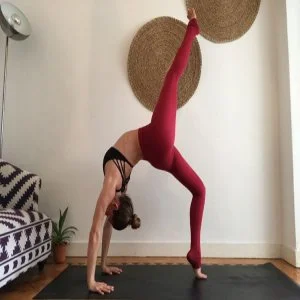
Eka Hasta Urdhva Dhanurasana (One-Armed Wheel Pose)
Since you’re essentially balancing upside down with just one arm supporting you off the floor, this variation is an excellent way to develop your arms.
How to do :
Starting in a regular Wheel Pose, slowly shift your weight into your right hand. Try to balance the weight on both legs by pressing the ground firmly away from you.
Once you feel stable, raise yourself onto your left hand’s fingers and try to elevate it off the floor by activating your core.
Before letting go and performing the identical movements on the opposite side, pause for a few deep breaths.
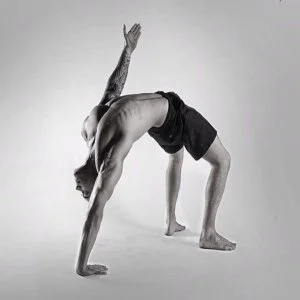
Chest-to-Wall
How to do :
Position your body for your typical wheel. In this stance, place a wall behind your hands.
Press up into the entire wheel and move back until your hands touch the wall.
As you expand and open through the core of your heart, press your chest backward against the wall.
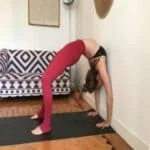
Dwi Pada Viparita Dandasana (Forearm Wheel)
Dwi Pada Viparita Dandasana, also known as the Two-Legged Inverted Staff pose, is a contemporary variation of the Wheel, even though it is technically a distinct yoga practice. This pose tests your flexibility and provides a gentle stretch by creating a deeper opening in your shoulders and chest.
How to do :
Enter the complete wheel. Release the top of your head very gently to rest on the mat while maintaining a strong core and legs.
Release one forearm to the ground from this position, then the other.
To elevate your head off the mat once more, clench your fingers or put your hands in a prayer position, then use your forearms to actively press the earth away.
Feel the stretch from your shoulders through your armpits, chest, and entire anterior body as you extend your heart toward the back of your mat.
You can walk your feet closer to your hands or farther apart to stretch your legs. If you’re very flexible, you can even raise one leg and move your foot into your hand to grip the foot.
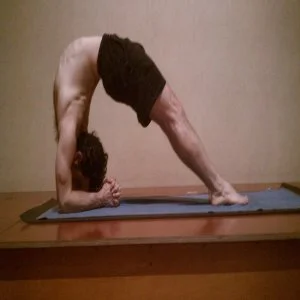
What are the Chakrasana’s precautions and contraindications?
You must be mindful of some warnings and contraindications when performing Chakrasana:
- If you have high blood pressure, stay away from this pose.
- Because it puts a lot of strain on your wrist, we advise avoiding this one if you have shoulder or wrist problems like tendinitis.
- Avoid this yoga pose if you’re healing from a neck injury, slipping disc, torn ligaments, fractured bones, or any other medical issue.
- If you have shoulder problems, carpal tunnel syndrome, lower back pain, or instability—such as a history of dislocation—avoid this pose.
- Because they can exacerbate diastasis recti, deep backends, and other poses involving excessive spinal extension are generally discouraged after the second trimester of pregnancy or after you begin to show.
- Avoid them if you have cardiac issues.
- If you have diarrhea or a headache, you should not perform.
- If you have a hernia, stay away.
What are the dos and don’ts for Chakrasana?
DO’S:
- Breathe slowly and rhythmically.
- Maintain a comfortable and relaxed neck and scapulae area.
- Maintain smooth, relaxed facial muscles.
- Maintain your knees and arms outstretched.
- For improved balance and support during the posture, maintain a certain amount of space between your feet.
- Don’t force yourself into the posture; instead, respect and appreciate your body.
DON’TS:
- Use more energy to raise the body into the posture, which could put undue pressure on the arms.
- Make an effort to raise your spine’s arch.
- tension and strain the body as you enter the pose and/or as you execute it.
Which common mistakes should one avoid when performing Chakrasana?
To get the most out of this stance without straining yourself or getting hurt, steer clear of these pitfalls.
Hyperextending Lower Back
Overstretching your gluteus maximus (butt) muscles can cause your pelvis to tilt upward, flattening your spine and hyperextending your lower back. Don’t overdo it; just strengthen your glutes.
Spreading Knees and Feet
Your lower back will become flat if you spread your knees and feet apart. If you’re having difficulties with the legs parting and the feet coming out, consider keeping the legs parallel by placing a block between your thighs.
Conclusion
In conclusion, there are many advantages to Chakrasana, from enhanced lung capacity and flexibility to pituitary and thyroid gland stimulation. However, when performing this position, safety must come first. Enjoying the benefits of this potent pose without taking unnecessary risks requires a thorough warm-up, precise technique, and supervision from a certified yoga instructor.
Never forget to pay attention to your body and adjust the stance to suit your comfort level. You will quickly witness the profound improvements in your physical and emotional well-being that Chakrasana offers with regular practice and the right safety measures.
FAQs
What are the benefits of Chakrasana?
The Wheel Pose, also known as Chakrasana, has numerous advantages. It increases blood flow to organs and tissues while revitalizing the heart. This improved circulation reduces inflammation, cholesterol, and blood pressure. Additionally, it strengthens the spine, increases flexibility, and enhances general physical and mental health.
What is called Chakrasana?
The back-bending pose known as Chakrasana, also called Full-Wheel Pose or Upward Bow Pose (Urdhva Dhanurasana), engages the entire body while toning the arms, thighs, and abdomen.
Which disease is cured by Chakrasana?
By increasing flexibility, strengthening muscles, and expanding lung capacity, Chakrasana helps alleviate ailments like respiratory problems, back discomfort, and poor digestion. It promotes general health and ameliorates some physical ailments, even if it might not be able to treat illnesses.
Can I do Chakrasana every day?
Strength, flexibility, and general well-being can all be enhanced by performing Chakrasana three to four times a week.
Does Chakrasana reduce weight?
Encourages Weight Loss: By strengthening the core, this position aids in fat loss, especially around the belly. Toned bodies can be achieved via consistent practice. Boosts Flexibility: This pose encourages hip, shoulder, and spine flexibility, all of which are critical for general mobility and injury avoidance.
References:
- Ezrin, S. (2021, November 11). The Benefits of Chakrasana, aka Wheel Pose. Healthline. https://www.healthline.com/health/fitness/chakrasana-benefits
- Singh, S. (2024, August 14). Benefits of Chakrasana and How to Do It. Truemeds. https://www.truemeds.in/blog/benefits-chakrasana-wheel-pose
- Physiotherapist, N. P.-. (2024, November 6). Chakrasana: Health Benefits,Types,Variations and How to perform? Mobile Physiotherapy Clinic. https://mobilephysiotherapyclinic.in/chakrasana-yoga-position/
- Singh, S. (2024b, August 14). Benefits of Chakrasana and How to Do It. Truemeds. https://www.truemeds.in/blog/benefits-chakrasana-wheel-pose


